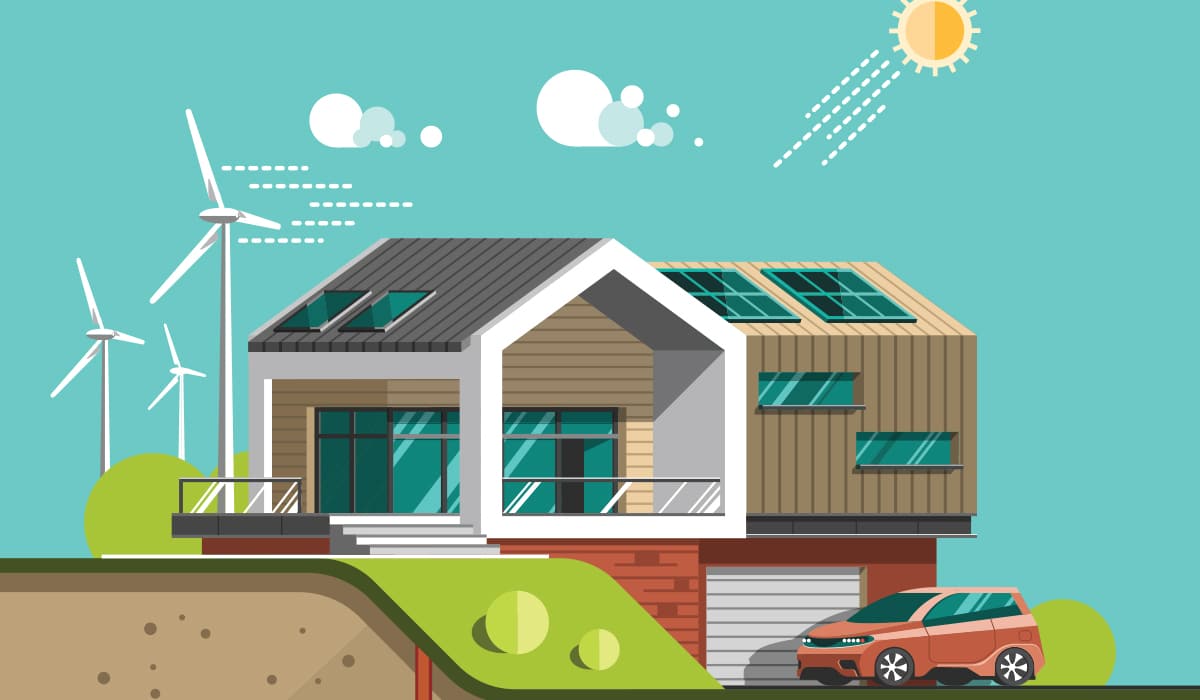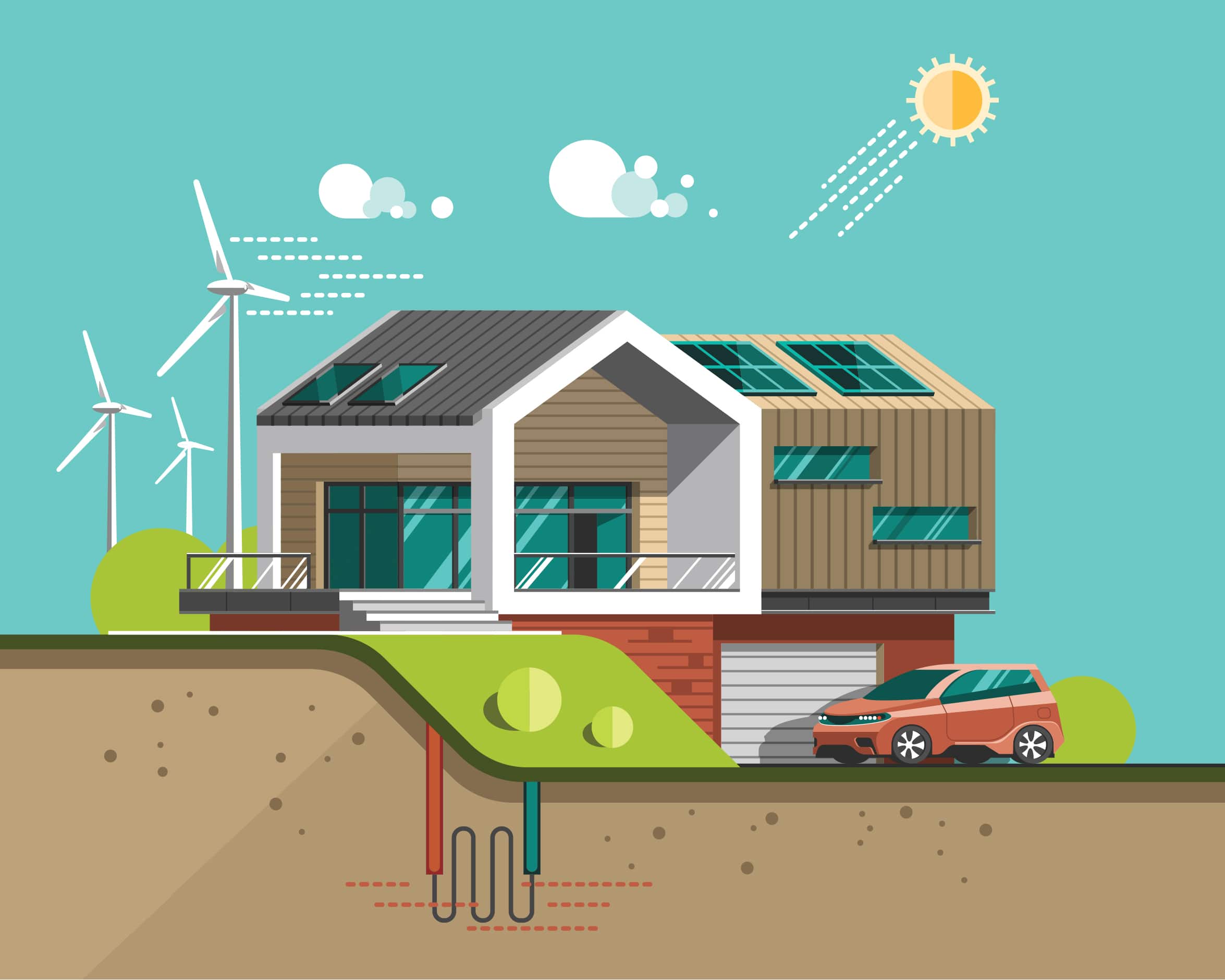From small-scale installations to carbon-neutral houses – how the different ways we heat and power our homes impact the planet.
Whether you’re boiling a kettle for your mid-morning brew, catching up on your favourite television show or turning the heat up a notch to escape colder weather, many of the utilities inside your home use precious energy. In this modern age, it’s almost impossible to live without consuming energy, but what we can control is where we get this energy from.
Fossil fuels such as coal, gas and oil were some of the earliest sources of energy. Since ancient times, burning coal was used to heat homes as it burned for longer periods than wood. Since then, humans have continued to mine coal. It’s a primary source of fuel for electricity production, while other fossil fuels like gas are used to heat water in European homes.
As the world’s population has increased, the demand for fossil fuels has too. Today, not only are they running out, but the harmful emissions from burning these fossil fuels to support the energy needs of 8 billion people is having a dire impact on planet Earth. It is now well known among scientists and the public that heating houses using fossil fuels contributes significantly to greenhouse gases and global warming. But thanks to the innovative work of renewable-energy engineers, living comfortably does not have to come at the expense of the environment. Natural and clean sources of energy from flowing bodies of water, wind and sunshine can also be converted into a limitless source of electricity, increasingly taking over from burning fossil fuels.
Hydropower is the most widely used form of green energy worldwide.
Boiler types
How much does the choice of water heater impact the environment?
1. Electric
Cold water enters the heater and is heated inside by electricity, as we do in South Africa, instead of burning gas or oil. This has an efficiency of around 99 per cent.
2. Biomass
This boiler involves the burning of wood pellets, wood chips or logs to heat water. The process still releases carbon dioxide, but it uses a more renewable material with much lower carbon emissions. Growing the plant materials for biomass boilers also captures some carbon.
3. Gas
Most UK homes have gas boilers. An average household using this boiler emits around 2.2 tonnes of carbon dioxide every year. They are rarely more than 93 per cent efficient.

Green-roof homes
Some buildings have flat roofs entirely covered in plants. As well as being easier on the eye, this design feature helps insulate homes, keeping warm air in and soundproofing them. As the plants grow, they absorb solar heat instead of reflecting it away from the building as typical roofs do. The trapped air that gets stuck between the individual plants serves as a natural insulator. Green roofs have extra benefits, such as providing more natural habitats for wildlife, absorbing water to reduce the load on drainage systems and improving sound insulation to block out weather and traffic noises. Sound waves with lower frequencies are blocked by the soil in the roof, and the plants themselves absorb higher frequency sound waves.
Modern green-roof technology was invented in the 1960’s, presumably after reading The Hobbit.
Did you know?
98 percent of Norway’s energy is from renewable sources.
Super-green eco homes
Eco Arch Kent, England
This house’s arched shape bears heavy loads with reduced materials. 26 000 clay tiles, covered with a green roof, provide good insulation. Solar generation powers the electricity and hot water.
Kingspan Lighthouse Watford, England
This is a net-zero-carbon home. In the ceilings is a phase-changing material that absorbs the heat in the rooms and reverses the process to release it into the rooms at night.
Slip House London, England
The boxes in this low-energy house’s design are staggered to optimise the area where light can enter the building.
Superadobe, California
Homes built with sandbags and covered in ceramic, like this one in Hesperia, California, eliminate the need for wood in construction, reducing deforestation.
Malator Earth House Pembrokeshire, Wales
For minimal impact on the surrounding landscape, Malator is built into the Welsh hills. It has a large window to keep the home well lit.
Smart and sustainable living
Peer inside an eco-friendly house to discover the technologies that utilise and protect the environment
1. Wind turbines
These turbines are installed outside homes. Even a light breeze can turn the aerodynamic blades. The kinetic energy produced by rotation is turned into electrical energy by a generator.
2. Photovoltaic panels
When light from the Sun hit these panels, electrons are released and an electric current is generated.
3. Solar panels
Solar energy is absorbed by these panels and converted into heat energy. These panels can reach up to 66°C.
4. Rainwater harvesting
A tank collects rainwater from gutters as it runs off the rooftop. This can be used in the garden or delivered straight to toilet cisterns as flushing water.
5. Hydro genie
A device called a Hydro Genie makes a home’s water heating more efficient. It removes dissolved oxygen in the water, which can form bubbles of air and slow heat transfer.
6. Heat pump
Air surrounding the house enters this device, where it is compressed, its heat extracted and exchanged into the house’s circulated water after it passes through the heat pump.
7. Geothermal heat pumps
Ground-to-water heat pumps transfer heat trapped in the ground below homes to water inside pipes. This heated water can be used for naturally sourced underfloor heating.
8. Draught-proofing
Old buildings can lose up to 20 per cent of their internal heat due to draughts. Adding secondary glazing to old windows can prevent this and lower energy usage.
Making clean energy more accessible
One of the main reasons why so many people in Europe rely on gas boilers is because sustainable options, such as heat pumps, are generally much more costly to install. However, with the climate crisis and energy crisis combined, governments and companies are thinking more about how to make green energy solutions affordable and accessible. Aira is a home energy company that launched in June 2023, dedicated to replacing Europe’s widespread gas boilers with air-to-water heat pumps. Daniel Särefjord, the chief executive of Aira in the UK, explains that ‘residential buildings account for ten per cent of the total direct emissions in Europe’. The UK, which has more than 20 million residential homes, uses gas because it is ‘artificially cheap,’ Särefjord says, explaining that heat pumps are a less expensive option for long-term use. Generally, heat pumps maintain the same internal temperatures as traditional gas boilers but are a cleaner alternative.
Air-to-water types are easier to install as they can be connected to the radiator system already in place. Making it easier to choose green energy technologies for our homes has the potential to drastically lower human impact on the environment. Theoretically, if everyone just in the UK replaced their gas boiler with a heat pump, nearly 37 million tonnes of CO2 per year could be prevented from entering the atmosphere.
By Ailsa Harvey
Images: Getty/Alamy/Shutterstock







